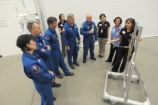Jul 31 2010
A novel docking navigation system for the International Space station (ISS) was demonstrated successfully by Ball Aerospace, Lockheed Martin and NASA at the Boulder-based facility of Ball.
The sensors incorporated in this system could mediate easier and safer crewed and uncrewed operations. This prototype will be tested during the Sensor Test for Orion Relative Navigation Risk Mitigation (STORRM) Development Test Objective (DTO), as part of NASA’s shuttle mission STS-134 in February 2011,undocking the crew on the 11th day of the mission. On Day 11 of the mission, the shuttle crew will undock from ISS by an Orion space craft.
 Ball aero space crew members
Ball aero space crew members
NASA’s space craft is equipped with thermal protection systems, innovative composites, structures, navigation systems and avionics. STORRM’s sensors determine distance, shape intensity, and can be used to enhance applications that are earth-bound namely deforestation monitoring, transportation hazardous warning systems and terrain mapping.
Two sensors developed by Ball constitute STORRM’s hardware. They are the high-definition Docking Camera (DC) and LiDAR Vision Navigation Sensor (VNS). An avionics and flight software from NASA is also incorporated in STORRM. These sensors incorporated in the Orion space craft will provide 16 times greater resolution of real-time 3D images, in addition to the provision of securing data from several miles, in comparison to existing shuttle sensors. Its unique design meets power constraints, mass, volume and crew safety, by virtue of its range capability and docking accuracy.
Data collected during this mission will be monitored using the STORRM software and the S-Band video sends snapshots of the screen to mission control for evaluation by the team. According to Larry Price, Lockheed Martin’s Orion deputy program manager, this innovative technology, if successful on orbit, will help in the successful launch of Orion in 2013.